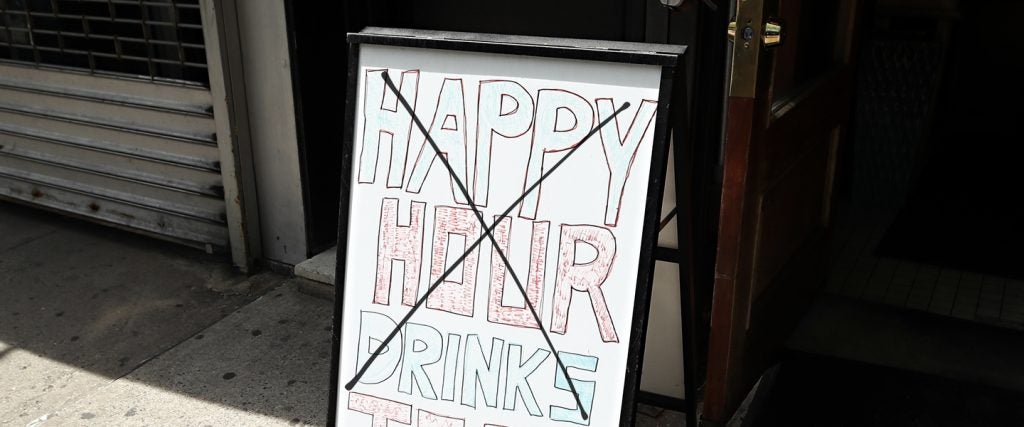The debate around legalizing all kinds of drugs has gained momentum in the last decade, with a major push around marijuana and, more recently, psychedelics like psilocybin shrooms and ketamine. Lawmakers and their constituents alike keep reckoning with the fact that the War on Drugs, much like Prohibition before it, has been a massive failure.
But one of the weirdest side effects of America’s battle with its favorite substances is the persistence of a ban that many of us simply don’t notice. You may have heard of “dry counties” in states like Alabama and Texas, but this is a more nuanced kind of prohibition: Statewide bans on happy hour drink specials.
Massachusetts is considered the first U.S. state to debut a happy hour ban back in 1984, and it remains one of eight states that upholds such a law today, joined by Alaska, Indiana, North Carolina, Oklahoma, Rhode Island, Utah and Vermont. There have been a number of attempts to repeal said ban in many of these states, most recently involving 2021 legislation in Massachusetts. But the happy hour ban lingers on, fueled by paranoia around drunk driving, even while lacking research to confirm the policy has any real impact.
Consider it a reflection of America’s uncomfortable relationship with individual rights, especially when there are real fears that encouraging excessive drinking with cheap prices could lead to fatalities on the road home. It seems absurd that small businesses can be prevented from offering discounts on their wares — but such is the power of the moral panic around irresponsible intoxication.
It’s no coincidence that the happy hour ban arose in the same era as the passage of the National Minimum Drinking Age Act and the birth of Mothers Against Drunk Driving (MADD). Through the 1970s, drunk driving was seemingly ignored by the masses as a systemic problem; many offenders, even those who caused fatal accidents, were sent home with a misdemeanor infraction and little more than a stern warning.
But the growth of mass media at the turn of the 1980s, coupled with increasingly conservative social views on intoxication and criminality during Ronald Reagan’s presidency, led to a sea change in American attitudes. The moral war against drunk driving was sparked by news stories around young victims, including 13-year-old Cari Lightner, who became a symbol of a movement when her mother Candy founded MADD.
Everything about drunk driving was being scrutinized for the first time in American society, and the crosshairs eventually landed on happy hour — that hallowed period of discount booze intended to draw in office workers at the end of their day. Though there wasn’t much empirical evidence to prove a link, a number of concerned voices hypothesized that cheap drinks, sold within a limited window of time, would encourage people to drink to excess. This would lead to more accidents on crowded roads, the theory went.
Three decades later, the jury is decidedly still out on whether banning happy hour accomplished anything at all. What is more obvious is that major policies such as instituting a federal drinking age minimum, enforcing legal standards around blood alcohol levels in drivers and mandating seatbelt use all helped dramatically reduce drunk driving accidents and fatalities. But there’s still very little evidence that keeping the masses from sucking down $4 margaritas between the hours of 4 and 6 p.m. is necessary for public safety. (The only upside, it seems, is that the city can collect fines by busting businesses that offer discounts on booze without abiding by happy-hour restrictions.)
One study from Canada in 1986 found little cause to credit happy-hour bans with helping reduce accidents, and 45 years later, the question still lingers. A review of 2019 accident data from the National Highway Traffic Safety Administration suggests that states with happy hour bans do not show any consistent decrease in drunk driving fatalities compared to states without those bans. In fact, the highest percentage of drunk driving deaths came from Rhode Island, which passed its ban on happy hour discounts in 1985.
There’s also the context to consider: A 2011 report from the Department of Transportation notes that the vast majority of fatal alcohol-related car accidents still unfold between the hours of 9 p.m. and 6 a.m. Then there’s the fact that a disproportionate number of drunk driving deaths happen in rural areas; turns out, driving in a city may make you less prone to killing yourself or someone else while buzzed.
As for the future of drunk-driving prevention? The Centers for Disease Control and Prevention, for one, continues to recommend direct efforts like lowering the BAC percentage for a DUI (one common suggestion is to bring it down from 0.08 to 0.05 percent), as well as widely publicizing enforcement efforts such as sobriety checkpoints to deter irresponsible driving. However, some critics argue that chronic DUI offenders need more substantial, long-term help than the threat of jail time or fines — a task that will require more rehauling of our courts and criminal justice system, with the addition of resources to counsel and rehabilitate, rather than just punish. Adding more public transit to cities is also a proven way to discourage drunk driving.
But right now, a happy hour ban remains a weird, oppressive policy that burdens small businesses who need to attract customers during off-peak hours and prevents law-abiding citizens from delighting in drink specials. Clutching to an outdated law in the hopes it’ll do something, when no data suggests that it does? That just feels anti-American — and it’s not a good reason for eight states to micromanage their bars.

